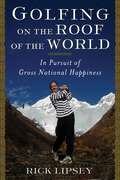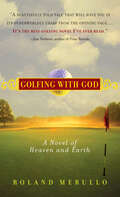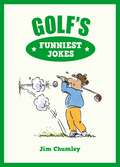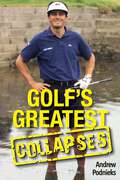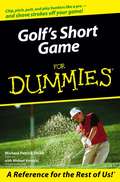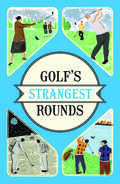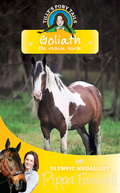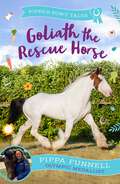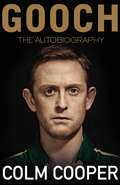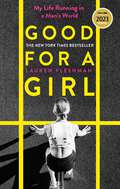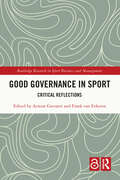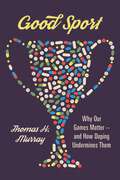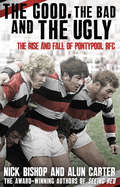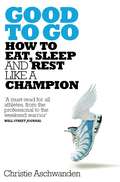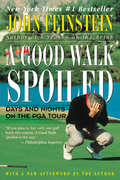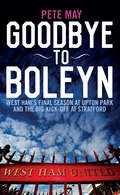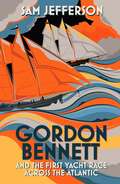- Table View
- List View
Golfer and Equipment (large print)
by RnibThere are three images on this page: a golfer teeing off, a golf club and a golf ball with three golf club heads. There is a locator dot shown, which will be at the top left of the page when the image is the correct way up. There is a dashed line image border surrounding each image. The image of the golfer is on the left of the page. He is seen from the side standing facing to the left, with his head turned to the front so that all his facial features can be found. His head is in the top right of the image and down from this is his body on the right and his arm on the left. His hand holds the grip (handle) of the club and its shaft continues diagonally down to the head in the bottom left of the image. He is about to hit the ball, which sits on its tee (a small peg) to the left of the club's head. He is using a club called a driver or wood. It has a large, heavy head and is designed to hit the ball a great distance: sometimes as far as the hole. The golfer's legs are in the bottom right of the image. He wears a short-sleeved purple shirt and light blue shorts and shoes. The image of the golf club is in the middle of the page. It is the same driver used by the golfer to the left, shown at a larger scale. Its grip is in the top right of the image and its head in the bottom left. The golf ball and golf club heads can be found on the right of the page. The golf ball, with its characteristic dimples, is shown at actual size at the top of the image. Down the page you will find the head of another style of driver with a more rounded shape. Further down is the head of an iron, used for hitting the ball shorter distances. Each type of iron has its head set at a different angle to the shaft giving varying amounts of 'loft' or height to the ball. At the bottom of the image is a putter, used to knock the ball into the hole on the smooth turf of the green. It has a wide head with a panel of hardwood set into it. Golfers will carry a selection of clubs, each appropriate to hit the ball in a different location: the fairway, the rough, a bunker or on the green.
Golfer and Equipment (UEB contracted)
by RnibThere are three images on this page: a golfer teeing off, a golf club and a golf ball with three golf club heads. There is a locator dot shown, which will be at the top left of the page when the image is the correct way up. There is a dashed line image border surrounding each image. The image of the golfer is on the left of the page. He is seen from the side standing facing to the left, with his head turned to the front so that all his facial features can be found. His head is in the top right of the image and down from this is his body on the right and his arm on the left. His hand holds the grip (handle) of the club and its shaft continues diagonally down to the head in the bottom left of the image. He is about to hit the ball, which sits on its tee (a small peg) to the left of the club's head. He is using a club called a driver or wood. It has a large, heavy head and is designed to hit the ball a great distance: sometimes as far as the hole. The golfer's legs are in the bottom right of the image. He wears a short-sleeved purple shirt and light blue shorts and shoes. The image of the golf club is in the middle of the page. It is the same driver used by the golfer to the left, shown at a larger scale. Its grip is in the top right of the image and its head in the bottom left. The golf ball and golf club heads can be found on the right of the page. The golf ball, with its characteristic dimples, is shown at actual size at the top of the image. Down the page you will find the head of another style of driver with a more rounded shape. Further down is the head of an iron, used for hitting the ball shorter distances. Each type of iron has its head set at a different angle to the shaft giving varying amounts of 'loft' or height to the ball. At the bottom of the image is a putter, used to knock the ball into the hole on the smooth turf of the green. It has a wide head with a panel of hardwood set into it. Golfers will carry a selection of clubs, each appropriate to hit the ball in a different location: the fairway, the rough, a bunker or on the green.
Golfer and Equipment (UEB uncontracted)
by RnibThere are three images on this page: a golfer teeing off, a golf club and a golf ball with three golf club heads. There is a locator dot shown, which will be at the top left of the page when the image is the correct way up. There is a dashed line image border surrounding each image. The image of the golfer is on the left of the page. He is seen from the side standing facing to the left, with his head turned to the front so that all his facial features can be found. His head is in the top right of the image and down from this is his body on the right and his arm on the left. His hand holds the grip (handle) of the club and its shaft continues diagonally down to the head in the bottom left of the image. He is about to hit the ball, which sits on its tee (a small peg) to the left of the club's head. He is using a club called a driver or wood. It has a large, heavy head and is designed to hit the ball a great distance: sometimes as far as the hole. The golfer's legs are in the bottom right of the image. He wears a short-sleeved purple shirt and light blue shorts and shoes. The image of the golf club is in the middle of the page. It is the same driver used by the golfer to the left, shown at a larger scale. Its grip is in the top right of the image and its head in the bottom left. The golf ball and golf club heads can be found on the right of the page. The golf ball, with its characteristic dimples, is shown at actual size at the top of the image. Down the page you will find the head of another style of driver with a more rounded shape. Further down is the head of an iron, used for hitting the ball shorter distances. Each type of iron has its head set at a different angle to the shaft giving varying amounts of 'loft' or height to the ball. At the bottom of the image is a putter, used to knock the ball into the hole on the smooth turf of the green. It has a wide head with a panel of hardwood set into it. Golfers will carry a selection of clubs, each appropriate to hit the ball in a different location: the fairway, the rough, a bunker or on the green.
Golfing on the Roof of the World: In Pursuit of Gross National Happiness
by Rick LipseyRick Lipsey returned from a vacation with an unusual job offer. After playing a few rounds at Bhutan's Royal Thimphu Golf Club, one of the members asked if he'd consider becoming the kingdom's golf pro. "Sure, I'd love to move to Bhutan," Lipsey flippantly responded. Next thing you know, he, his wife, and their infant daughter are boarding a plane for this remote Himalayan country. With one foot in the ancient world and the other in the twenty-first century, Bhutan is working to successfully meld the old and the new, from subsistence farming and religious festivals to the Internet and World Wrestling Entertainment. In Golfing on the Roof of the World, Rick sets great golf travel writing against the bigger political story of Bhutan's entrance to the modern world. Not only does he teach and play golf in the shadow of the world's tallest peaks, but he also comes to understand the seismic shifts in store for the last Buddhist kingdom where peace and spiritual prosperity have abounded, and the national standard for measuring success is Gross National Happiness.
Golfing with God: A Novel of Heaven and Earth
by Roland MerulloHerman "Hank" Fins-Winston was a pro golfer destined for greatness. Now he lives in a condominium on the thirteenth fairway of one of heaven's glorious courses – a fact he finds surprising and amusing, since for one reason or another, a fair percentage of golfers never make it to paradise. Hank is having the time of his afterlife until he's summoned one idyllic morning to play a round with the Almighty. It seems that God is having some trouble with His game. As they play the heavenly courses, both in paradise and back on earth, Hank comes to realize that what began as a golf lesson has become a spiritual journey.
Golf's Funniest Jokes
by Jim ChumleyWhy did the golfer’s wife ask to be buried on the golf course? So she could be sure her husband would visit her grave. After a long day on the fairway, put away the patterned jumper and five-iron and laugh off the double-bogeys with this selection of hysterical jokes. Golf’s Funniest Jokes will suit golf fanatics to a tee.
Golf’s Greatest Collapses
by Andrew PodnieksGolf's Greatest Collapses recounts the agony-andsometimes humour-of the worst moments of agolfer's career, the moment when he can't do anythingright. Golfers collapses are borne of the weight of themoment, the gaze of thousands of fans, the click ofphotographers' cameras, the underlying awarenessthat millions of people around the world are watching.Some golfers never recover from a collapse; othersuse it to learn, and when the situation recurs, they arewiser and better able to handle the pressure of themoment. Collapses can be good in the long run, or theycan be forever devastating.
Golf's Short Game For Dummies
by Michael Patrick Shiels Michael KernickiEasy-to-grasp techniques for improving the short game About 70 percent of the shots in a round of golf are taken 75 yards from the pin or closer, making the short game the most significant factor in a golfer's score. This practical guide shows readers how to shave strokes off their game by improving their pitching, chipping, bunker play, and putting. Golfers will find expert tips on choosing the right wedges, putters, and balls, as well as illustrated step-by-step instructions on swings used in short-game shots. They'll also find information on how to beat bunkers and other hazards and how to play various lies-in deep rough, from the fairway, uphill, side-hill, and off bare ground. There's also a section on stretches, exercises, and drills to improve techniques, as well as tips on reading greens for accurate putting. Michael Patrick Sheils (Birmingham, MI) is a member of the Golf Writers Association of America. He has written four books, and his articles and columns have appeared in worldwide magazines and newspapers. Michael Kernicki (Miami Beach, FL) has been a PGA member for 27 years and is currently the Head Professional at the historic Indian Creek Country Club in Miami Beach.
Golf's Short Game For Dummies
by Michael Patrick Shiels Michael KernickiEasy-to-grasp techniques for improving the short game About 70 percent of the shots in a round of golf are taken 75 yards from the pin or closer, making the short game the most significant factor in a golfer's score. This practical guide shows readers how to shave strokes off their game by improving their pitching, chipping, bunker play, and putting. Golfers will find expert tips on choosing the right wedges, putters, and balls, as well as illustrated step-by-step instructions on swings used in short-game shots. They'll also find information on how to beat bunkers and other hazards and how to play various lies-in deep rough, from the fairway, uphill, side-hill, and off bare ground. There's also a section on stretches, exercises, and drills to improve techniques, as well as tips on reading greens for accurate putting. Michael Patrick Sheils (Birmingham, MI) is a member of the Golf Writers Association of America. He has written four books, and his articles and columns have appeared in worldwide magazines and newspapers. Michael Kernicki (Miami Beach, FL) has been a PGA member for 27 years and is currently the Head Professional at the historic Indian Creek Country Club in Miami Beach.
Golf's Strangest Rounds: Extraordinary But True Stories From Over A Century Of Golf (Strangest Ser.)
by Andrew Ward‘The most eccentric golf book ever’ Sports and Leisure Magazine
Goliath the Rescue Horse: Book 13 (Tilly's Pony Tails #13)
by Pippa FunnellMeet Tilly Redbrow, who doesn't just love horses - she lives, breathes and dreams them too! At World Horse Welfare, Tilly meets neglected shire horse Goliath, and she's determined to help him find a new home.For every girl who has ever longed for a pony of her own, these delightful, warm and engaging stories are packed with Pippa Funnell's expert advice on everything you ever wanted to know about horses.
Goliath the Rescue Horse (Pippa's Pony Tales #13)
by Pippa FunnellTilly dreams of having a pony of her own. One that only she can ride to stardom. Will her wishes come true when she joins Silver Shoe Farm Stables?Tilly learns all about World Horse Welfare and, when she visits their rehabilitation centre, she falls in love with gentle giant, Goliath, the shire horse. What can she do to help find him a new home?Collect all 18 titles in this series of irresistible, uplifting and heartwarming pony adventures. Printed in a dyslexia friendly font and packed with up to date tips from three times Olympic Medallist, Pippa Funnell, as well as a helpful glossary and black and white illustrations on every spread.
Gooch - The Autobiography
by Colm Cooper'The greatest Gaelic footballer of all time.' Pat SpillaneWhen Colm Cooper retired from inter-county football in 2017, he left behind a remarkable legacy. The holder of five All-Ireland medals and eight All-Stars, he was Kerry’s stand-out forward for fifteen years. From a family steeped in Gaelic football, and a core member of the Dr Crokes team, Colm was still in his teens when he first played for Kerry at senior level. Overcoming struggles with injury and personal tragedy, Cooper became one of the GAA’s most recognizable and best-loved figures at a time of tumultuous change in the game. But the man known nationally as ‘Gooch’ is also an intensely private figure who has never courted publicity and his personal story remains largely untold. Now Gooch – The Autobiography unlocks a previously unopened door, tracing a compelling path through the life beyond the headlines. This is the story of an ordinary man who became an extraordinary footballer.
Good for a Girl: My Life Running in a Man's World
by Lauren Fleshman'Women's sports have needed a manifesto for a long time. With Good for a Girl we finally have one' Malcolm Gladwell 'The invitation to have a long overdue conversation for a long overdue cultural shift' Alysia Montaño, Olympian, co-founder of &Mother, and author of Feel-Good Fitness 'This is the book we've been waiting for' Kate Fagan, author of What Made Maddy RunLauren Fleshman has grown up in the world of running. One of the most decorated collegiate athletes of all time and a national champion as a pro, she was a major face of women's running for Nike before leaving to shake up the industry with feminist running brand Oiselle and coach elite young female runners. Every step of the way, she has seen how our sports systems - originally designed by men, for men and boys - fail young women and girls as much as empower them. Girls drop out of sports at alarming rates once they hit puberty, and female collegiate athletes routinely fall victim to injury, eating disorders or mental health struggles as they try to force their way past a natural dip in performance for women of their age.Part memoir, part manifesto, Good for a Girl is Fleshman's story of falling in love with running as a girl, battling devastating injuries and self-doubt, and daring to fight for a better way for female athletes. Long gone are the days when women and girls felt lucky just to participate; Fleshman and women everywhere are waking up to the reality that they're running, playing and competing in a world that wasn't made for them. Drawing not only on her own story but also on emerging research on the physiology and psychology of young athletes of any gender, Fleshman gives voice to the often-silent experience of the female athlete and argues that the time has come to rebuild our systems of competitive sport with women at their centre.Written with heart and verve, Good for a Girl is a joyful love letter to the running life, a raw personal narrative of growth and change, and a vital call to reimagine sports for young women.
Good Governance in Sport: Critical Reflections (Routledge Research in Sport Business and Management)
by Arnout Geeraert Frank Van EekerenThis book fills an important gap in the sport governance literature by engaging in critical reflection on the concept of ‘good governance’. It examines the theoretical perspectives that lead to different conceptualisations of governance and, therefore, to different standards for institutional quality.It explores the different practical strategies that have been employed to achieve the implementation of good governance principles. The first part of the book aims to shed light on the complexity and nuances of good governance by examining theoretical perspectives including leadership, value, feminism, culture and systems. The second part of the book has a practical focus, concentrating on reform strategies, from compliance policies and codes of ethics to external reporting and integrity systems. Together, these studies shed important new light on how we define and understand governance, and on the limits and capabilities of different methods for inducing good governance.With higher ethical standards demanded in sport business and management than ever before, this book is important reading for all advanced students and researchers with an interest in sport governance and sport policy, and for all sport industry professionals looking to improve their professional practice.The Open Access version of this book, available at www.taylorfrancis.com, has been made available under a Creative Commons Attribution-Non Commercial-No Derivatives 4.0 license.
Good Governance in Sport: Critical Reflections (Routledge Research in Sport Business and Management)
by Arnout Geeraert Frank Van EekerenThis book fills an important gap in the sport governance literature by engaging in critical reflection on the concept of ‘good governance’. It examines the theoretical perspectives that lead to different conceptualisations of governance and, therefore, to different standards for institutional quality.It explores the different practical strategies that have been employed to achieve the implementation of good governance principles. The first part of the book aims to shed light on the complexity and nuances of good governance by examining theoretical perspectives including leadership, value, feminism, culture and systems. The second part of the book has a practical focus, concentrating on reform strategies, from compliance policies and codes of ethics to external reporting and integrity systems. Together, these studies shed important new light on how we define and understand governance, and on the limits and capabilities of different methods for inducing good governance.With higher ethical standards demanded in sport business and management than ever before, this book is important reading for all advanced students and researchers with an interest in sport governance and sport policy, and for all sport industry professionals looking to improve their professional practice.The Open Access version of this book, available at www.taylorfrancis.com, has been made available under a Creative Commons Attribution-Non Commercial-No Derivatives 4.0 license.
Good Sport: Why Our Games Matter -- and How Doping Undermines Them
by Thomas H. MurrayWhy are fiberglass vaulting poles and hinged skates accepted in sport - while performance-enhancing drugs are forbidden? Are the rules that forbid them arbitrary? Should we level the playing field by allowing all competitors to use drugs that allow them to run faster or longer, leap higher, or lift more? In this provocative exploration of what draws us to sport as participants and spectators, Thomas Murray argues that the values and meanings embedded within our games provide the guidance we need to make difficult decisions about fairness and performance-enhancing technologies. Good Sport reveals what we really care about in sport and how the reckless use of biomedical enhancements undermines those values. Implicit in sports history, rules, and practices are values that provide a sturdy foundation for an ethics of sport that celebrates natural talents and dedication. You see these values when the Paralympics creates multiple level playing fields among athletes with different kinds of impairments. They appear again in sports struggles to be fair to all when an extraordinary woman athlete emerges who appears to possess a mans hormone profile and muscles. They are threatened when the effort to assure athletes a fair chance to win without doping is subverted by cheating or by corruption, as in the case of Russias state-supported doping operation. Performance-enhancing drugs distort the connection between natural talents, the dedication to perfect those talents, and success in sport. Explaining the fundamental role of values and meanings, Good Sport reveals not just what we champion in the athletic arena but also, more broadly, what we value in human achievement.
Good Sport: Why Our Games Matter -- and How Doping Undermines Them
by Thomas H. MurrayWhy are fiberglass vaulting poles and hinged skates accepted in sport - while performance-enhancing drugs are forbidden? Are the rules that forbid them arbitrary? Should we level the playing field by allowing all competitors to use drugs that allow them to run faster or longer, leap higher, or lift more? In this provocative exploration of what draws us to sport as participants and spectators, Thomas Murray argues that the values and meanings embedded within our games provide the guidance we need to make difficult decisions about fairness and performance-enhancing technologies. Good Sport reveals what we really care about in sport and how the reckless use of biomedical enhancements undermines those values. Implicit in sports history, rules, and practices are values that provide a sturdy foundation for an ethics of sport that celebrates natural talents and dedication. You see these values when the Paralympics creates multiple level playing fields among athletes with different kinds of impairments. They appear again in sports struggles to be fair to all when an extraordinary woman athlete emerges who appears to possess a mans hormone profile and muscles. They are threatened when the effort to assure athletes a fair chance to win without doping is subverted by cheating or by corruption, as in the case of Russias state-supported doping operation. Performance-enhancing drugs distort the connection between natural talents, the dedication to perfect those talents, and success in sport. Explaining the fundamental role of values and meanings, Good Sport reveals not just what we champion in the athletic arena but also, more broadly, what we value in human achievement.
The Good, the Bad and the Ugly: The Rise and Fall of Pontypool RFC
by Nicholas Bishop Alun CarterWhat made Pontypool such a great seam of talent for the Welsh national team? Why were they hated and feared in equal measure by other clubs in Wales and across the Severn? What made Ray Prosser a coach ahead of his time?In this engrossing book, Alun Carter and Nick Bishop recount the dramatic story of the rise and fall of one of the great enigmas of Welsh club rugby: Pontypool RFC. They chart the glories and violence of the amateur era in the 1970s and ’80s before the club entered a period of steady decline in the age of professionalism, reaching the point of bankruptcy after a crippling legal battle with the Welsh RU. It is a symbolic tale of the disintegration of the social fabric that held a once-great club together, both on and off the playing field – often irresistibly funny, eventually tragic, but always larger than life.
Good to Go: How to Eat, Sleep and Rest Like a Champion
by Christie AschwandenThe NEW YORK TIMES BESTSELLING account of the new frontier of sports recovery science, which shows what we should and shouldn't be doing between exercising to achieve maximum performance.'Christie Aschwanden is simply one of the best science writers in the world. Whether you’re striving for a personal best or simply wondering about that post-workout beer, Good to Go is the definitive tour through a bewildering jungle of scientific (and pseudo-scientific) claims that comprise a multi-billion dollar recovery industry.' - David Epstein, bestselling author of The Sports Gene.All athletes from Olympians to weekend warriors must toe the line between training and recovery to maximize the benefits of workouts and reach optimal performance. For the longest time, coaches and training manuals have emphasized training. But now sports science is homing in on an even more fundamental part: recovery.The aim of training is to force the body to adapt to stress, and this adaptation is what makes you fitter and better able to perform. But to adapt, you need to optimize recovery too. You only benefit from training that you can recover from, and the ability to recover determines how much training your body can handle. Recovery, the science shows, is a crucial component of exercise training and it’s starting to look like it may be the most important one.Good to Go is the first definitive account of this new frontier in sports and exercise science. This developing science informs not only professional athletes and sports teams, but also people who are exercising for health or fitness and those who are aiming to take a little off their personal record.Good to Go will take readers on an intimate, light-hearted journey through the science of exercise recovery, from ice-baths and cryogenic freezing chambers to the science behind Usain Bolt’s love of chicken nuggets and Tom Brady’s recovery pyjamas. In the same vein as David Epstein’s The Sports Gene and Bill Gifford’s Spring Chicken, Good to Go assesses the science and claims of a wide variety of recovery methods and potions, and debunks the junk to give a clear picture of what we should actually be doing to look after our bodies better between exercising.
A Good Walk Spoiled: Days and Nights on the PGA Tour
by John FeinsteinFrom the author of Raise a First, Take a Knee: John Feinstein's bestselling classic is "the best-ever account of life on the PGA tour" (Golf Magazine) and a must-read for anyone who loves the game of golf. Traveling with the golfers on the PGA Tour, Feinstein gets inside the heads of the game's greatest players as well as its struggling wannabes. Meet superstars like Nick Price, who nailed a fifty-foot putt at the seventeenth to win the British Open, and Paul Azinger, who marked his return from a bout with cancer with an emotional appearance at the Buick Open. Go behind the scenes for Davis Love III's unforgettable come-from-behind victory in the Ryder Cup. In golf, Feinstein eloquently relates, the line that separates triumph from disappointment is incredibly fine. "One week you've discovered the secret to the game; the next week you never want to play it again."
Good Walks: Rediscovering the Soul of Golf at Eighteen of the Carolinas' Best Courses
by Lee PaceThis book celebrates the beauty, tradition, and variety of golf across the Carolinas, featuring eighteen beloved courses as experienced by the walking golfer. One of golf's earliest appeals was its health-giving benefits, with players walking some four miles over varied terrain, making stamina and endurance an important part of the sport. Most recreational players today choose motorized carts. But Lee Pace believes that the slower pace and on-the-ground view associated with walking gives one an opportunity to savor the experience, understand the nuances of course design and landscape architecture, and appreciate the small touches that make our region's best clubs and courses special. The Carolinas are a cradle for the game in the United States, making walking its courses an ideal way to connect past and present. Attractively illustrated with full-color photography, each essay tells the story of a course and how it is experienced on foot. Guiding readers around fabled courses like Pinehurst No. 2 and new classics like Kiawah Island's Ocean Course, private clubs and municipal courses, resort destinations and urban gems, Pace reflects on legendary course architects, famous tournaments, notable players, ties between the game's founders and the Carolinas, and more. Whether you're a committed traditionalist or new to the game, this book will inspire you to slow down and enjoy the best of what golf has to offer.
Goodbye To Boleyn: West Ham’s Final Season at Upton Park and the Big Kick-off at Stratford
by Pete May"Essex scribe and literary Hammer Pete May writes with humour and eloquence about the most turbulent year of change at the Boleyn since Ken’s Café got a tub of Flora." Phill JupitusWest Ham's final season at the Boleyn Ground was always going to be memorable. It featured a new manager in Slaven Bilic, the arrival of a French magician called Dimitri Payet and away wins at Arsenal, Liverpool and Man City - not to mention an unexpected tilt at the top four and an epic last game at the Boleyn against Man United.But a new beginning is around the corner and, as he and his fellow Hammers prepare to swap the gritty East End streets of E13 for the shiny shopping centres of Stratford, lifelong supporter Pete May reflects on the special place the Boleyn Ground has occupied in the hearts of generations of Irons fans.Whether it's the infamous chants of the Bobby Moore Stand, the pre-match fry-ups at Ken's Café or the joys of sticky carpets, rubbish ale and blokes singing on pool tables in the pubs around Upton Park, Pete's memories are sure to resonate with legions of the claret-and-blue army as they say farewell to the Boleyn and enter a new era at the London Stadium.
Gordon Bennett and the First Yacht Race Across the Atlantic
by Sam JeffersonThe 1866 transatlantic yacht race was a match that saw three yachts battle their way across the Atlantic in the dead of winter in pursuit of a $90,000 prize. Six men died in the brutal and close-fought contest, and the event changed the perception of yachting from a slightly effete gentlemen's pursuit into something altogether more rugged and adventurous. The race also symbolized the beginning of America's 'gilded age', with its associated obscene wealth and largesse (the $90,000 prize put up by the three contestants is about $15 million in today's money), as well as the thawing of relations between the US and UK. The narrative focuses on the victorious yacht Henrietta and her owner James Gordon Bennett. Bennett was the son of the multimillionaire proprietor of the New York Herald, and a notorious playboy. His infamous stunts included driving his carriage through the streets of New York naked, tipping a railway porter $30,000, and turning up at his own engagement party blind drunk and mistaking the fire for a urinal, which led to the coining of the phrase 'Gordon Bennett!'. However, Bennett was also a serious yachtsman and had served with distinction during the civil war aboard Henrietta, and he was the only owner to be aboard his own boat during the race. Other characters include Bennett's captain Samuel Samuels (legendary clipper skipper, ex-convict and occasional vaudeville actor), financier Leonard Jerome, aboard Henrietta as race invigilator (he also happened to be grandfather to Winston Churchill) and Stephen Fisk, a journalist so desperate to cover the race that he evaded a summons to appear as a witness in court and instead smuggled himself aboard Henrietta in a crate of champagne. Using the framework of the race to discuss the various historical themes, there's ample drama, and the diverse and eccentric range of characters ensure that this is a book laced with plenty of human interest, scandal and adventure.
Gordon Bennett and the First Yacht Race Across the Atlantic
by Sam JeffersonThe 1866 transatlantic yacht race was a match that saw three yachts battle their way across the Atlantic in the dead of winter in pursuit of a $90,000 prize. Six men died in the brutal and close-fought contest, and the event changed the perception of yachting from a slightly effete gentlemen's pursuit into something altogether more rugged and adventurous. The race also symbolized the beginning of America's 'gilded age', with its associated obscene wealth and largesse (the $90,000 prize put up by the three contestants is about $15 million in today's money), as well as the thawing of relations between the US and UK. The narrative focuses on the victorious yacht Henrietta and her owner James Gordon Bennett. Bennett was the son of the multimillionaire proprietor of the New York Herald, and a notorious playboy. His infamous stunts included driving his carriage through the streets of New York naked, tipping a railway porter $30,000, and turning up at his own engagement party blind drunk and mistaking the fire for a urinal, which led to the coining of the phrase 'Gordon Bennett!'. However, Bennett was also a serious yachtsman and had served with distinction during the civil war aboard Henrietta, and he was the only owner to be aboard his own boat during the race. Other characters include Bennett's captain Samuel Samuels (legendary clipper skipper, ex-convict and occasional vaudeville actor), financier Leonard Jerome, aboard Henrietta as race invigilator (he also happened to be grandfather to Winston Churchill) and Stephen Fisk, a journalist so desperate to cover the race that he evaded a summons to appear as a witness in court and instead smuggled himself aboard Henrietta in a crate of champagne. Using the framework of the race to discuss the various historical themes, there's ample drama, and the diverse and eccentric range of characters ensure that this is a book laced with plenty of human interest, scandal and adventure.

